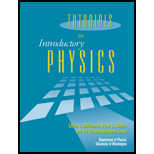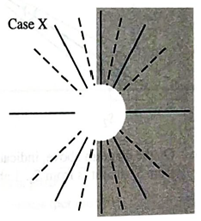
Tutorials in Introductory Physics
1st Edition
ISBN: 9780130970695
Author: Peter S. Shaffer, Lillian C. McDermott
Publisher: Addison Wesley
expand_more
expand_more
format_list_bulleted
Concept explainers
Textbook Question
Chapter 25.1, Problem 2aTH
Label each nodal line and line of maximum constructive interference in the shaded region with the appropriate value of

Expert Solution & Answer
Want to see the full answer?
Check out a sample textbook solution
Students have asked these similar questions
Hi! I need help with these calculations for part i and part k for a physics Diffraction Lab. We used a slit width 0.4 mm to measure our pattern.
Examine the data and % error values in Data Table 3 where the angular displacement of the simple pendulum decreased but the mass of the pendulum bob and the length of the pendulum remained constant. Describe whether or not your data shows that the period of the pendulum depends on the angular displacement of the pendulum bob, to within a reasonable percent error.
In addition to the anyalysis of the graph, show mathematically that the slope of that line is 2π/√g . Using the slope of your line calculate the value of g and compare it to 9.8.
Chapter 25 Solutions
Tutorials in Introductory Physics
Ch. 25.1 - The top view diagram at right illustrates two...Ch. 25.1 - The top view diagram at right illustrates two...Ch. 25.1 - Label each nodal line and line of maximum...Ch. 25.1 - Prob. 2bTHCh. 25.1 - How do the angles a and ß compare? Explain.Ch. 25.1 - Prob. 3bTHCh. 25.1 - Prob. 3cTHCh. 25.1 - The enlarged diagram at right illustrates the...Ch. 25.1 - For what values of D (in terms of ) will there be:...Ch. 25.1 - Use your answers from parts d and e to write...
Ch. 25.1 - Determine the angles for which there will be nodal...Ch. 25.1 - Consider the following incorrect statement...Ch. 25.2 - In the space above the photograph at right,...Ch. 25.2 - The screen is 2.2m from the slits, and the...Ch. 25.2 - Suppose that the width of the right slit were...Ch. 25.2 - The graph of intensity versus angle at right...Ch. 25.3 - The photograph at right illustrates the pattern...Ch. 25.3 - The photograph at right illustrates the pattern...Ch. 25.3 - Consider the original doubleslit pattern from...Ch. 25.3 - Consider the original doubleslit pattern from...Ch. 25.3 - Consider the original doubleslit pattern from...Ch. 25.3 - Prob. 3aTHCh. 25.3 - Monochromatic light from a distant point source...Ch. 25.4 - Light from a distant point source is incident on a...Ch. 25.4 - The graph at right shows the intensity on a...Ch. 25.4 - The graph at right shows the intensity on a...Ch. 25.4 - There is a systematic way of determining the...Ch. 25.4 - There is a systematic way of determining the...Ch. 25.4 - There is a systematic way of determining the...Ch. 25.5 - Monochromatic light from a distant point source is...Ch. 25.5 - Monochromatic light from a distant point source is...Ch. 25.5 - Light from a laser (=633nm) is incident on two...Ch. 25.5 - Monochromatic light from a distant point source is...Ch. 25.5 - Monochromatic light from a distant point source is...Ch. 25.5 - Monochromatic light from a distant point source is...Ch. 25.6 - Recall the situation from tutorial, in which light...Ch. 25.6 - Recall the situation from tutorial, in which light...Ch. 25.6 - A plate of glass (n=1.5) is placed over a flat...Ch. 25.6 - A plate of glass (n=1.5) is placed over a flat...Ch. 25.6 - A plate of glass (n=1.5) is placed over a flat...Ch. 25.7 - Identical beams of light are incident on three...Ch. 25.7 - Prob. 1bTHCh. 25.7 - Unpolarized light of intensity I0 incident on a...Ch. 25.7 - Unpolarized light of intensity I0 incident on a...Ch. 25.7 - Unpolarized light of intensity I0 incident on a...Ch. 25.7 - Unpolarized light of intensity I0 incident on a...Ch. 25.7 - Unpolarized red light is incident on two...Ch. 25.7 - Unpolarized red light is incident on two...Ch. 25.7 - Unpolarized red light is incident on two...Ch. 25.7 - Unpolarized red light is incident on two...
Additional Science Textbook Solutions
Find more solutions based on key concepts
Fibrous connective tissue consists of ground substance and fibers that provide strength, support, and flexibili...
Human Biology: Concepts and Current Issues (8th Edition)
Approximately how many feet is the Missouri River above sea level? Height above sea level: _________ feet
Applications and Investigations in Earth Science (9th Edition)
What is the difference between cellular respiration and external respiration?
Human Physiology: An Integrated Approach (8th Edition)
Answer the following questions for each compound: a. How many signals are in its 13C NMR spectrum? b. Which sig...
Organic Chemistry (8th Edition)
Calculate the mass of NaCl in a 35-mL sample of a 1.3 M NaCl solution.
Introductory Chemistry (6th Edition)
Why are BSL-4 suits pressurized? Why not just wear tough regular suits?
Microbiology with Diseases by Body System (5th Edition)
Knowledge Booster
Learn more about
Need a deep-dive on the concept behind this application? Look no further. Learn more about this topic, physics and related others by exploring similar questions and additional content below.Similar questions
- An object is placed 24.1 cm to the left of a diverging lens (f = -6.51 cm). A concave mirror (f= 14.8 cm) is placed 30.2 cm to the right of the lens to form an image of the first image formed by the lens. Find the final image distance, measured relative to the mirror. (b) Is the final image real or virtual? (c) Is the final image upright or inverted with respect to the original object?arrow_forwardConcept Simulation 26.4 provides the option of exploring the ray diagram that applies to this problem. The distance between an object and its image formed by a diverging lens is 5.90 cm. The focal length of the lens is -2.60 cm. Find (a) the image distance and (b) the object distance.arrow_forwardPls help ASAParrow_forward
arrow_back_ios
SEE MORE QUESTIONS
arrow_forward_ios
Recommended textbooks for you
 Principles of Physics: A Calculus-Based TextPhysicsISBN:9781133104261Author:Raymond A. Serway, John W. JewettPublisher:Cengage Learning
Principles of Physics: A Calculus-Based TextPhysicsISBN:9781133104261Author:Raymond A. Serway, John W. JewettPublisher:Cengage Learning University Physics Volume 3PhysicsISBN:9781938168185Author:William Moebs, Jeff SannyPublisher:OpenStax
University Physics Volume 3PhysicsISBN:9781938168185Author:William Moebs, Jeff SannyPublisher:OpenStax Glencoe Physics: Principles and Problems, Student...PhysicsISBN:9780078807213Author:Paul W. ZitzewitzPublisher:Glencoe/McGraw-Hill
Glencoe Physics: Principles and Problems, Student...PhysicsISBN:9780078807213Author:Paul W. ZitzewitzPublisher:Glencoe/McGraw-Hill Physics for Scientists and Engineers: Foundations...PhysicsISBN:9781133939146Author:Katz, Debora M.Publisher:Cengage Learning
Physics for Scientists and Engineers: Foundations...PhysicsISBN:9781133939146Author:Katz, Debora M.Publisher:Cengage Learning University Physics Volume 1PhysicsISBN:9781938168277Author:William Moebs, Samuel J. Ling, Jeff SannyPublisher:OpenStax - Rice University
University Physics Volume 1PhysicsISBN:9781938168277Author:William Moebs, Samuel J. Ling, Jeff SannyPublisher:OpenStax - Rice University College PhysicsPhysicsISBN:9781938168000Author:Paul Peter Urone, Roger HinrichsPublisher:OpenStax College
College PhysicsPhysicsISBN:9781938168000Author:Paul Peter Urone, Roger HinrichsPublisher:OpenStax College

Principles of Physics: A Calculus-Based Text
Physics
ISBN:9781133104261
Author:Raymond A. Serway, John W. Jewett
Publisher:Cengage Learning

University Physics Volume 3
Physics
ISBN:9781938168185
Author:William Moebs, Jeff Sanny
Publisher:OpenStax

Glencoe Physics: Principles and Problems, Student...
Physics
ISBN:9780078807213
Author:Paul W. Zitzewitz
Publisher:Glencoe/McGraw-Hill

Physics for Scientists and Engineers: Foundations...
Physics
ISBN:9781133939146
Author:Katz, Debora M.
Publisher:Cengage Learning

University Physics Volume 1
Physics
ISBN:9781938168277
Author:William Moebs, Samuel J. Ling, Jeff Sanny
Publisher:OpenStax - Rice University

College Physics
Physics
ISBN:9781938168000
Author:Paul Peter Urone, Roger Hinrichs
Publisher:OpenStax College
Convex and Concave Lenses; Author: Manocha Academy;https://www.youtube.com/watch?v=CJ6aB5ULqa0;License: Standard YouTube License, CC-BY